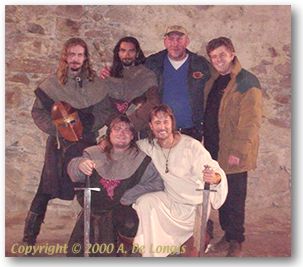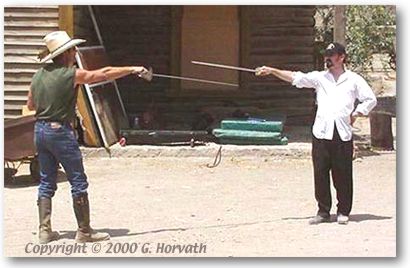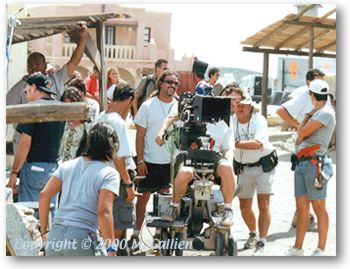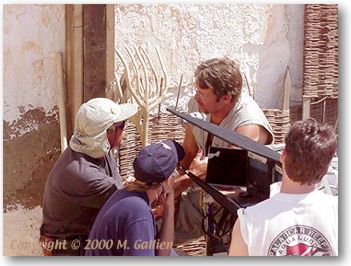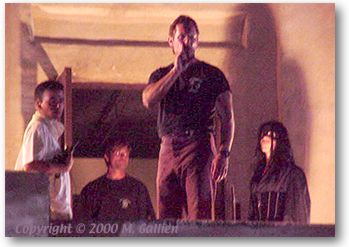

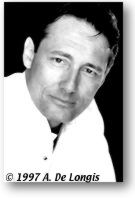
So You Want To Be A Swordmaster / Action Coordinator?



So You Want To Be A Swordmaster / Action Coordinator?
I was playing third lead in the pilot for a new series, Ariana's Quest, starring Rena Mero. I had a wonderful part, the leading lady was very talented and a pleasure to work with, the locations were picturesque and the work was especially challenging since we filmed a feature length production in fifteen shooting days. As you might imagine, the pace was frantic and the days long with short turnarounds and more of the same in the days that followed. That was all the time we had so we did what was necessary to get the job done.
Lloyd Simandl and Danny Virtue were co-directors and co-producers for North American Pictures. Danny gave me a call based on our work together when I guest starred on "Hawkeye" with Lee Horsley and Linda Carter. Petr Drozda, the European bronze medalist and wrestling Olympian coordinated the stunts. I had the pleasure of working with a very talented Czech Sword Master named Milan Slepicka. I also contributed by coaching Rena on her technique and performance with the sword and helping her translate the story and character elements in Milan's choreography. The directors liked how well Milan and I worked together and rewrote my final scene to give us a featured "battle of champions" sword fight. We co-choreograped the multiple weapons fight and had a ball. Two sword masters throwing their favorite cool moves at each other. The end result was spectacular. I'll give you a full report of my Czech adventures after I catch up on my Queen of Sword behind-the-scenes commentary.
Which brings me to a little discussion on what exactly a Sword Master and Stunt Coordinator does. Some of you seemed to want more detail on what exactly the job entails, including who makes what decisions. I hope this both entertains and helps to answer those questions in the context of my work on The Queen of Swords.
The Sword Master
It is the Sword Master's job to create choreography that tells the story of the scene as executed by the show's specific characters at the specific place and time as written in that particular scene. I always discuss story with the director and character concerns with the actors. When you work on a show for a while you become very familiar with the characters the writers and individual actors are trying to create, and your choreographic choices reflect those needs and opportunities. Action that doesn't progress the story and say something specific about each unique character is indulgent, lazy, and a disservice to the show and its audience.
The Sword Master's imagination has only two constant qualifiers. The first involves safety - always the prime consideration. The Sword Master must analyze the skill level of each performer and the amount of time he has to teach them his choreography. If his choices are beyond the ability of the actor to execute safely and at a reasonable level of performance, then he must find simpler choices that still tell the story. This was especially true for my tour of duty on Queen of Swords where, except for Tessie, we had no fight doubles for any principal performer or for the guest stars, unless they could be doubled by me. and the director chose to use the double. In such situations, it is even more important for the Sword Master to choose what the actor him or herself can safely perform. That is how I see the job and approach my work.
The second consideration on television is how much time you have to physically shoot your action scene. An episodic television show gets only seven days to shoot the entire episode, including all the action. Every day is of necessity overbooked, and unforseen problems often steal what little time you've been promised. On each of the episodes I helped to create, I showed the directors the fight and had them agree to the story of the choreography before I taught the moves to the actors. This does not, however, set the choreography "in stone." Inevitably, when we got to the set and time had ticked away shooting other elements, we often had to pull out an entire phrase or make last-minute adjustment to shorten the fight, hopefully without sacrificing any essential story elements. Making those tough choices and getting the actors through the changes safely and effectively also is an important part of the job.
Now who has control over what gets shot and how those choices are edited is a bit more complex. As Sword Master I was responsible for the safety of the performers and of the crew during any sword action. Usually, the director and director of photography saw the moves expressing important story elements themselves. I could suggest what I thought needed special coverage, such as a fancy move or a particularly clever disarm, but once it's been shot, the Sword Master is out of the loop.
Lens choices and camera placement to cover the action were always the decision of the director and the DP, and it was the script continuity clerk's job to keep track of shot order. I always hoped the actors' performances, the director's camera setups, and the shot order would make the choreography's story clear to the editor, so that what I saw in my mind would be reflected in his assemblage. Often the editors, half a world away in Canada, have other instructions and concerns when they assemble the entire tapestry of the show. The editor makes his choices and the final edit is approved or changed by the Producers before the episode hits the airwaves.
The Stunt Coordinator
It is the Stunt Coordinator's job to create and execute the most exciting action he and his team can dream up and safely bring to the screen. There is always inherent risk in even the simplest action, but proper planning and a thorough knowledge of the skills and training of the team's members can lower those risks to acceptable levels. When you enter a foreign location shoot from North America and work with a local co-coordinator, the people whose work you know are half a world away. You must rely on your new partner's team and quickly familiarize yourself with what they know. The other constant concerns in episodic television are budget and time. Given plenty of both you can pretty much recreate anything your fertile imagination can fathom. However, a weekly series has a limited budget that often tightens as the series progresses. And time is rarer than ice cubes in the Sahara.
Here's how it works. You receive the script to the next show while you're filming the current episode. You must quickly read the new script and imagine the best action sequences to most entertainingly and effectively tell the story the authors have created. Your solution won't always be on the page, either. For example, the script for "Honor Thy Father" called for the crucial attempted rape and pitchfork fight between Tessa and Ramon to occur in a stable. We didn't have a stable set either in town or at the Hacienda location and there certainly wasn't time in our overcrowded shooting schedule to shift the entire cast, crew and all the equipment to yet another location. To solve the problem, we cleaned up a junk-filled yard adjacent to the hacienda and let the art department work their magic. They added bamboo thatching to cover a modern-looking corrugated roof, covered metal pipes and electrical conduits, and added a wagon, a carriage, and a horse tethered inside. Voila - a carriage yard!
The director, Brian Grant, also wanted the rape to be foiled in the yard and the fight to climax at the top of the hill near the graves of Tessa's father and mother, because it would make the scene more dramatic and poignant. There was no way we could have motivated the 200 yard uphill travel from the hacienda proper, so we had to create "television geography". Rather than the carriage yard, we showed the horse and the actors exit from an abandoned livestock shed closer to the graves on the opposite side of the hill from the house. We didn't have the time and manpower to clean out and dress another set, so we positioned cameras to only show the exit of the horse and Ramon's pursuit of Tessa - a simple problem that needed to be solved to tie the action of our fights together. It wasn't perfect but it told the story and got the job done.
It's a waste of energy to dream up action that you don't have the time, budget, personnel or equipment to make happen. So my partner, Ricardo Cruz and I put our years of combined experience together to come up with do-able ideas before marching into production meetings with each new director and all the department heads armed with their own ideas for what they had read. Each new script was broken down and each department expressed their ideas as to what we could and couldn't accomplish in the schedule allotted. The director usually had different ideas or at least questions of his own that often provided inspiration for something entirely different that told the desired story even better.
Another goal is to always try to make your action look bigger and better, especially if it doesn't add time or cost. For example, in "Duel With A Stranger," the Queen throws a lamp onto the floor to start a fire that allows her to escape from a burning hotel room. Richard Martin was the episode's director and a good friend from our experiences together on Highlander: The Series' "Duende."He told me he was satisfied to simply get a shot of stunt double Natalia Guijarro bursting through the doors and clearing camera. The ball of flame would follow once she was safely out of the line of fire. Ricardo Cruz wanted to set up some boxes covered with a stunt mat in case Natalia lost her footing or got tangled in the door debris and fell over the second story balcony's wall. It was our standard concern to always build in extra measures of safety wherever we could.
The Special Effects department had fireproofed (with asbestos sheeting) the hotel room's ceiling area behind the double doors where the gas-fed flame bars would burn at the end of the fight. Mary Gallien doubled as the Queen for the second unit shots in the room, including shattering lamps and leaping flames. A second area, also prepared with an asbestos ceiling and French doors with pre-cut "breakaway" frames and spun sugar glass, was created to permit Natalia to easily crash through them during her escape from the burning room.
We performed the fight in this small room with the actors. I'll talk about the thrill of staging a sword fight in a room with a ceiling low enough to touch with your outstretched hand when I write the details of "Duel with a Stranger." Rehearsal time had been spent on bigger, more complex fights in the same episode; this fight, by director's choice was small. After shooting the principals together, Mary sword-doubled as the Queen so the guest star could increase his speed and intensity of performance on his camera coverage and close-ups. I did the same for Tessie's coverage. Since we'd spent months training together, this enabled Tessie to go for it with confidence.
Meanwhile, down the hall the doors were being replaced and the fire gag set up. This included a controlled explosion and ball of flame to shoot through the doors behind the escaping Queen double. Did I mention both the doors AND the curtains would be on fire? This called for Natalia to wear layers of flame retardant clothing soaked with protective gel as a standard safety measure.
But I had an idea to get more bang for our buck. I suggested to Ricardo that Natalia could actually JUMP from the balcony if we raised the boxes and mats a bit higher. Natalia's specialty is horses and she's terrific, but she had less than 2 months of training in swordfighting, whipwork, and falls higher than horse tumbles. However, a small jump small would be within both Natalia's comfort and safety levels.
By making the stunt a small jump, Natalia could burst through the doors, cross the six feet of balcony and safely jump over the wall to the waiting mat and boxes. We set up a ramp to make the step up to her takeoff point atop of the balcony wall easy so Natalia would be in balance before her leap. Oh, did I mention that she was carrying the Queen's sword? That situation also had to be addressed as a safety problem to be solved and rehearsed since the sword was a practical metal fighting sword. After nearly four months and numerous requests, we still didn't have any rubber stunt swords for these special occasions.
Now the point of this whole idea was twofold. Natalia would be safer and the shot could be much more dramatic. With Natalia leaping off the balcony, we no longer had to worry about her safety from the exploding ball of flame - she would be gone and out of the way. If we timed the explosion to her leap we could also use a much bigger ball of fire that would silhouette her in front of a wall of flame as she jumped from the wall. Ricardo and I spoke with our Special Effects wizard, Carlos Hernandez and we ran some tests to gauge the proper size of the explosion for the desired effect by standing on the balcony to see how far the flames could safely be extended.
I convinced the director and the DP that this was a win/win situation and would definitely be worth changing the planned camera placements to cover our extended action. It makes me very proud and very happy every time I see one of my idea translated so beautifully to the screen. The results of our efforts are now yours to enjoy each week as part of the opening credit sequence of the show.
These are the sort of things a Stunt or Action Coordinator tries to bring to the job. You are responsible for your department and the safety of the actors and your team. In this instance stunts and EFX (Special Effects) had come up with a way to do the shot safer and more effectively and it cost neither extra time nor extra money. It's all part of a team effort with a common goal, make the show look great. So you do the best you can with what you've got and use your imagination to fill in the gaps.
I'll be writing more behind-the-scenes material, picking up with "Death to the Queen." I'm also shooting a new teaching video entitled, "Broadsword for the Stage and Screen: The De Longis Method," as a followup for my "Rapier for the Stage and Screen." We will be filming next weekend and then I travel to Vancouver for a month.
Thank you for your interest and thank you for your patience with my schedule.
Back to the Queen of Swords Index Page
Copyright 2000 Anthony De Longis. All contents, unless otherwise noted, are the property of Anthony De Longis or used with permission of the copyright owner. All text and photos herein may not be reproduced or distributed without the express written consent of Anthony De Longis, his official representative, or the copyright owner.
The Queen of Swords is trademark of Fireworks Productions, Toronto, Canada, and is a production of Fireworks (Canada), Amy Productions (UK), Morena Films (Spain) and M6 (France), and is distributed in the United States by Paramount. The Official Queen of Swords Website can be found at http://www.thequeenofswords.com.
This page designed and maintained by Scorpio Rising. Send Comments
This page last updated November 4, 2000

